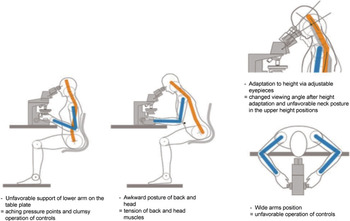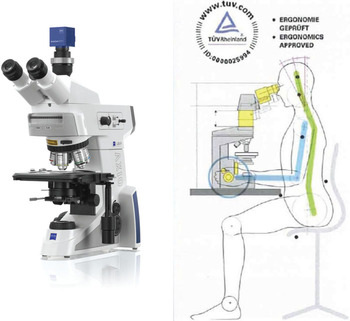Introduction
Microscope users can become fatigued by awkward sitting positions and complicated controls. This affects many users in microbiology, cytology, hematology, and pathology labs. In recent years researchers have conducted studies to examine microscope ergonomic issues for users with various body heights [Reference Schäcke and Holper1, 2]. This research is critical because data from occupational and medical literature clearly indicate that occupational-based injuries at the workplace are common where microscopes are used extensively. Muscular-skeletal conditions, including shoulder, neck, and back aches, are the most prevalent injuries, with more than 77% of users experiencing these issues [Reference Schäcke and Holper1].
Ergonomic Studies
Body posture. Several leading microscope manufacturers have been investigating these problems. Carl Zeiss Microscopy began its most recent series of ergonomic studies in 2002 with Henssler and Schultheiss Product Design, a globally renowned engineering, research, consulting, and corporate design firm [2]. The study was based on empirical examination results from a group of 15 participants. The study examined typical work situations and evaluated them on the basis of key ergonomic data. The study concentrated on routine users who spend several hours a day at a microscopy workstation.
The ergonomic survey identified problems, such as insufficient microscope height that caused users to maintain awkward body postures when the viewing height was too low. Figure 1 shows that the majority of users with an ergonomically correct sitting posture at the worktable find it difficult to look into the eyepieces of a conventional laboratory microscope. The figure shows the body height distribution of men and women around the world, including population groups from Scandinavia, Central and Eastern Europe, Japan, and Southeast Asia. The black-lined user shape indicates that only five percent of women worldwide are smaller than the size shown; the blue-lined user shape illustrates that only five percent of men worldwide are taller than this size. Therefore, it is necessary for the microscope to have an adjustable viewing height.

Figure 1: Insufficient instrument height for different population groups.
When the viewing height is too low, users tend to gravitate toward awkward body postures. Adaptation to the viewing height using an adjustable tilting tube (labeled adjustable eyepieces in Figure 2) resulted in changed viewing and poor neck posture in the upper height positions. Lack of lower arm support resulted in aching pressure points and clumsy operation of the microscope. Other issues included tension on back and head muscles and poor operation of controls caused by the users holding their arms in a wide position. The main outcome of this first study [2] was to develop a vertically adjustable tube with an invariable viewing angle. This would allow optimal instrument height for an ergonomically correct viewing angle and sitting position.

Figure 2: Ergonomically awkward adaptation of the body posture.
Adjustable height microscope. Carl Zeiss Microscopy continued its research by conducting a more extensive study in 2004, in collaboration with its scientific partner the Institute for Occupational Medicine, Charité Hospital Berlin [Reference Schäcke and Holper1]. This included field studies at 20 clinical microscope workspaces in scientific and diagnostic departments (anatomy, pathology, neuropathology, and hematology) in 5 institutes at Berlin university hospitals. The study was used to compare the ergonomics of regularly used standard microscopes from such makers as ZEISS, Olympus, Leica, and Nikon with those of a modified microscope designed to be more ergonomically correct, Axio Imager with Ergotube 50-15-50 from ZEISS.
This model permitted height adjustments (from 0–50 mm), had a fixed 15° viewing angle, and an adjustable extension (from 0–50 mm). Twenty individuals participated in the study, which began with the administration of a questionnaire eliciting information on the study participant's occupation, workplace conditions, and occupational-based injuries of the muscular-skeletal system and eyes. Researchers then conducted a comparison and evaluation of microscope geometries of 20 regularly used microscopes with the modified microscope. Information collected included microscope geometries, adjustment of microscopes and workplaces according to individual needs, individual anthropometric data, evaluation of microscope ergonomics, and individual posture in front of the microscope used in a lateral view.
The study found that the majority of participants were able to adjust the new microscope and tube to achieve the correct ergonomic posture of the head, neck, and shoulders. The eyepiece extension's horizontal distance between microscope pupil and drives was shown to optimize manipulation depth. The 15° viewing angle was within the optimum range but lacked the ability to make individual adjustments. Adjustments between 8–30° would allow a more dynamic working posture. Figure 3 shows the improved ergonomics of the modified microscope over the standard.

Figure 3: Comparison of traditional and modified microscopes. Existing (old) microscope and tube (background image) and Axio Imager with Ergotube 50-15-50 (foreground image).
Project to Design the Most Ergonomic Microscope
In 2007, Carl Zeiss Microscopy started a project in conjunction with TÜV Rheinland, a world-renowned independent organization that certifies product safety and ergonomics. The Institute for Occupational Medicine, Charité Hospital Berlin again took part as the scientific partner of the project group. The goal of this project was the development of the most ergonomic laboratory microscope that can be built with today's knowledge and capabilities. The new product was called Axio Lab.A1.
The most important challenge for the project group was the question: How can we define an ergonomic standard for a microscope workplace? Of course there are numbers of norms and standards for computer workplaces, which describe how to install a monitor and how to adjust the chair at your workplace. But there have been no norms and standards that describe the workplace microscope. So the first target for the TÜV Rheinland was to collect and evaluate existing norms and standards to determine whether they are suitable for microscope workplaces or not. Finally numerous norms were adapted at a microscope workplace to create an ergonomic workplace that guarantees the most ergonomic posture and benefit for the microscope user:
• The new defined standard uses ergonomic and anthropometric data for the 95th percentile man for the large user and data for the 5th percentile woman for the small user.
• The angle of the binocular microscope eyepiece must be adjusted to enable the user to view slides with limited inclination of the neck, keeping the neck and shoulder muscles relaxed.
• The height of the microscope eyepiece and lens assembly should be adjustable to enable the eyepiece height to equate to the user's eye level.
• The arms should remain supported during operation of the microscope controls and to prevent fatigue and discomfort.
Based on the earlier ergonomic research, the project group established that the two crucial points are the adjustable viewing height and angle, as well as the accessibility of all three main adjustment elements (focus drive, stage drive, and brightness control) with one hand. As a result, Axio Lab.A1 was equipped with a continuously adjustable height tube from 0–50 mm. In addition, the tube can be swiveled continuously from 8–33°. The design focused on ensuring that the three main adjustment elements were located in close proximity. The main features, ergonomic tube and nearby adjustment elements, comply with a multitude of ISO, EN, and DIN standards and are designed to incorporate the latest scientific findings. Axio Lab.A1 is the first light microscope ever to gain this new TÜV “ergonomics approved” certificate [Reference Rheinland3].
Figure 4 shows a photo of Axio Lab.A1 with its key ergonomic features. The use of this TÜV ergonomics-approved Axio Lab.A1 configuration allows daily, continuous work with the microscope and can significantly reduce the risk of muscular injuries in the neck and shoulders. Figure 5 shows a photo demonstrating that all three main adjustment elements are within reach of the user's hand.

Figure 4: TUV-approved microscope with adjustable height tube and adjustable viewing angle.

Figure 5: Adjustment elements near the user's hand.
Conclusion
Ergonomic research, conducted over the last decade, identified several areas of concern for the body position of microscope users. Using these data, ZEISS designed a microscope with adjustable tube height and variable viewing angle that allows the user to work comfortably with proper posture.
Acknowledgment
The author thanks Thomas Bocher who initiated and consulted on this article.







